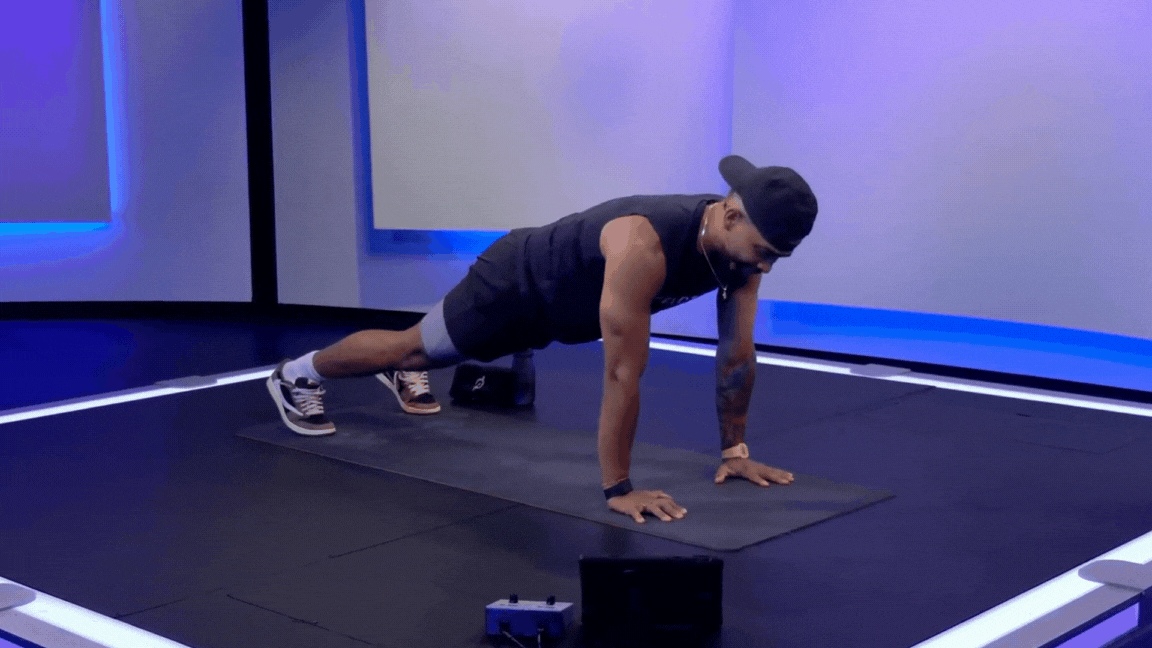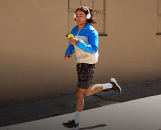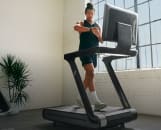What Are Bodyweight Exercises?
17 of the Best Bodyweight Exercises
How Effective Are Bodyweight Exercises?
Do Bodyweight Exercises Build Muscle?
Peloton instructor Rad Lopez explains the benefits of bodyweight exercises and shares the best moves for an effective full-body workout.
If you’re looking for an excuse-proof workout you can rely on at any time, I’d recommend bodyweight exercises. You don’t need any equipment, and you can get in a great workout practically anywhere, for as long or as short as you want—even if it’s just a few minutes.
What Are Bodyweight Exercises?
Bodyweight exercises are exercises that don’t require any weights, such as dumbbells, barbells, etc. Seriously, you don’t need any equipment to do this work. That means you can do these moves pretty much anywhere, any time. Instead of external resistance, bodyweight training uses your own bodyweight as the resistance.

Peloton App
Access thousands of classes with no equipment needed.
17 of the Best Bodyweight Exercises

1. Push-Up
Begin in a high plank position. Make sure your shoulders are stacked directly over your wrists. Position your arms and feet shoulder-width apart.
Bend your elbows to a 45-degree angle. Pause for a second. Your body should be hovering just above the floor.
Push through your palms to slowly return to the starting position.

2. Forearm Plank
Start in a forearm plank position: Place your forearms on the floor, parallel to each other. Your spine should be straight and parallel to the floor.
Brace your core as you push through your toes.
Hold this position for 10-60 seconds, keeping your body in a straight line. To modify this exercise, place your knees on the ground.

3. Bodyweight Squat
Start with your feet positioned a little wider than hip-width distance apart. Rotate your toes out to a 45-degree angle.
Imagine you’re about to sit down in a chair. Slowly bend your knees, sinking your lower body toward the ground. Keep your head and chest up.
Pause when your thighs are parallel to the floor. Push through your heels to return to the starting position.

4. Jumping Jacks
Begin with your feet together and your hands at your sides.
Jump your feet out to the sides, raising your arms out to the sides and over your head at the same time. (You can opt to clap your hands together over your head.)
Return to the starting position by jumping your feet back together and swinging your arms back down.
To modify this exercise, step your feet out to the sides instead of jumping.

5. Reverse Lunge
Start standing with your feet shoulder-width distance apart.
Take a large step back with your right foot, leaving your left foot rooted into the ground. Bend both legs, lowering until your left knee is bent at a 90-degree angle and your left thigh is parallel to the ground.
Step your right foot back to the starting position. Keep your head and chest up. Brace your core to protect your spine.
Switch sides and repeat, stepping back with the left leg.

6. Mountain Climber
Start in a high plank position. Keep your spine parallel to the floor. Engage your core to protect your spine.
Drive your knees in toward the center of your chest, alternating legs.

7. Burpee
Start in a standing position with your feet hip-width distance apart. Reach down to the ground. Place your hands on the floor and hop your feet back into a plank. (To modify, step your feet back instead.)
Lower your chest to the ground—or remain in your plank.
Hop or step your feet outside your hands.
Complete one squat jump—or bodyweight squat—and return to the starting position.

8. Bodyweight Renegade Row
Start in a high plank position.
Bend your right arm and drive your elbow toward your ribcage, squeezing your shoulder blades and rhomboids to activate and engage your upper back. Engage your core to protect your lower back. To modify this exercise, keep your knees on the ground.
Return your right arm to the starting position, then repeat on the left side.

9. Hip Bridge
Lie on the ground with your knees bent and your feet flat on the floor. Your heels should be about 6 to 8 inches away from your glutes.
Push your hips up toward the ceiling, creating a straight diagonal line from your feet to your hips. Squeeze your glutes at the top of this exercise.
Slowly lower your hips back down to the ground.

10. Good Morning
Start standing with your hands clasped behind your head and your feet hip-width distance apart, with a slight bend in your knees.
Engage your core. Hinge at your hips, allowing your upper body to tilt forward until your spine is parallel to the floor. Pause for a second.
Slowly lift up and return to the starting position.

11. Single-Leg Deadlift
Start standing with your feet hip-width distance apart and knees softly bent. Shift your weight into your right foot, lifting your left foot so your toes barely touch the ground.
Lift your left foot up behind you and lean your torso forward, reaching your left hand toward your right foot or shin. Keep your hips and left knee square to the floor.
Lower your foot and lift your torso to return to start, lightly tapping your right foot to the floor. Do the same number of reps on both sides.

12. Toe Touches
Lie on your back. Extend your legs straight up toward the ceiling.
Reach your fingertips toward your feet, lifting your head, neck, and shoulders off the ground.
Lower your upper body back to the ground. Keep your arms extended.
To progress this movement, extend your legs and arms in opposite directions, lowering them toward the floor.

13. Bear Plank
Start on all fours with your knees under your hips, your toes tucked, and your palms flat on the floor under your shoulders.
Engage your core and draw your shoulder blades back and down, then lift your knees so they hover a couple of inches off the floor. Keep your neck long, looking just ahead of your hands.
Hold this position for 10-60 seconds.

14. Reverse Fly
Stand with your feet hip-width distance apart and your knees softly bent. With your core engaged and your back flat, hinge forward at the hips to lean your torso forward at about 45 degrees. Extend your arms toward the floor beneath your shoulders, palms facing forward, with your hands in fists and your thumbs pointing out to the sides. Keep your neck long and gaze at the floor a few feet in front of your toes.
Without moving your torso, extend your arms out to the sides, up to shoulder height, squeezing your shoulder blades together.
Reverse the movement to return to the starting position.

15. Hand Release Push-up
Start in a high plank position with your palms flat on the floor under your shoulders and your feet hip-width distance apart.
Slowly lower your body to the floor in one piece. Once your chest is resting on the ground, lift your hands a couple of inches off the floor, engaging the muscles in your upper back. Keep your neck long and your gaze down at the floor.
Place your hands on the floor where they were, engage your core, and press into your palms to push up into high plank and return to start. If you need to modify, keep your knees on the floor for the push-up part of the movement.

16. Swimmer
Lay face-down on the floor with your legs long and arms stretched overhead, biceps by your ears. Lift your head, arms, and shoulders off the floor.
Keeping your arms straight and palms facing down, sweep your arms out to the sides and back toward your hips, squeezing your shoulder blades together. Stopping when they form a “V” shape with your fingers pointing toward your feet.
Reverse the motion, sweeping your arms forward until they’re by your ears. That’s one rep. Do the next rep without lowering your arms, head, and shoulders to the floor.
How Effective Are Bodyweight Exercises?
Bodyweight training is actually one of my favorite ways to train because it’s very efficient. As long as your muscles are under tension and are being challenged, these exercises are effective—and they’re super convenient when your equipment is limited.
Some people may think that bodyweight exercises aren’t as good as training with weights, but the truth is that as long as you’re challenging your muscles through repetition and time under tension and fatigue, any bodyweight exercise is an effective way to build strength and muscular endurance.
Another myth about bodyweight training is that it’s just for beginners. Not true! Bodyweight training is definitely a great entry point to strength training for someone with little to no experience. But depending on the moves, bodyweight exercises can work for everyone from beginners to professional athletes. I personally incorporate bodyweight exercises into my training all the time. My favorite exercise of all time is the push-up—I do about 200 a day.
Do Bodyweight Exercises Build Muscle?
One of the major benefits of bodyweight workouts is that you get your strength and your cardio in. Try a high-intensity interval training (HIIT) workout, and pick up the pace on those mountain climbers! Even running can be considered a bodyweight exercise. So next time you’re in the mood for a workout, consider starting with some bodyweight exercises to get the ball and those endorphins rolling.
Remember: The amount of weight you’re utilizing doesn’t matter. It’s more about the number of repetitions and the amount of fatigue that you’re challenging your body with. Between the resistance of your body weight and the correct amount of intensity, bodyweight exercises are great for building muscle. Bodyweight exercises have been shown to build muscle “independent of an external load,” according to a 2016 study in the journal Physiology and Behavior. In this case, an “external load” refers to dumbbells, weight machines, or resistance bands. So even without the equipment, you can still increase your muscle mass.
But on that note, it’s important to understand that your body will at some point become accustomed to the amount of resistance (weight), therefore limiting any further muscle growth. Progressive overload, or increasing resistance and weight load within the exercise, will be a key component if muscle growth is your goal.
Try a Bodyweight Class on the Peloton App
See all classesThis content is for informational and educational purposes only and does not constitute individualized advice. It is not intended to replace professional medical evaluation, diagnosis, or treatment. Seek the advice of your physician for questions you may have regarding your health or a medical condition. If you are having a medical emergency, call your physician or 911 immediately.
Build full-body strength
Enter your email to get articles, instructor tips, and updates from Peloton sent to your inbox.
By providing your email address, you agree to receive marketing communications from Peloton.
For more about how we use your information, see our Privacy Policy.







